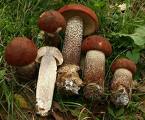Oak Turk (Leccinum quericinum)
6-24cm, hemispherical, and a growing sphere, properly coated circular, with adults sometimes slightly distorted around the edge of the furrow is occasional. The skin growing over the edge for a long time it is hanging, chunky rough, slightly cracked, in the elderly is almost smooth. Basically, red-brown, usually brick, chestnut or brown fritillary, the elderly are becoming lighter, sometimes almost cream, or as rust (then pressed blush of wine).
Tubule
Badly with a bouquet of deep, 10-35mm long, gray, cream, then brown the slices immediately become violet, lilac and darker.
Small, about 0.3 to 0.4 mm, rounded or slightly angular compact, at first white, then istobojne with tubes.
Darker brown.
Bunch
8-20/2-4cm, cylindrical or down a bit thicker, sometimes spindle-shaped or batinasto thicker at the bottom. Basically, white, down crvenosmđ growing in the base of the mycelium whitish coated. Densely covered with granular scales darker above all, from white to dark brown over crvenosmeđeg, the elderly almost to black. Full and firm, even slightly fibrous at the turn.
MEAT
Thick, compact, all aging soft, white or greyish permeated. At the intersection of it but for the 1-start from top to bottom 2minute permeate deep lilac, with gray, black and a hint that after 24 hours will become dominant. At some stage occurs after the lilac viskicrvena. The taste is pleasant, odor-free.
CHEMICAL REACTIONS
In KOH the skin and amber Klobuk cinoberkarmin, lower in meat bouquet of yellow-gray, the surface of a bouquet of olive, the orange tubes and pores, then the color of honey, and NH3, the meat of Pocrnela KOH diluted with blue-gray border. On a bouquet of NH3 by sulfur yellow, else nothing happens. The SV at the bottom of a bouquet of pink.
MICROSCOPY
Spores very light yellow, hyaline, coarse granular, elongated spindle-shaped, almost cylindrical: 12-16/4-5 mm size.
HABITAT AND DISTRIBUTION
End of oak species, but oak, very common, and in the lower regions of Croatia and Vojvodina's mass. He likes the lighter seats, mostly from the edge of the forest roads and very acid soils. Found in Europe.
AGE
It occurs mostly in late summer, early fall, precisely-from August to November. Some years there is also in June.
Edibility
Excellent edible mushroom, never worm-eaten. Saving to all the right ways and mushrooms, pickled and even the great, the only thing we do not know what the full flavor when dried. Cut off as he is a tough bunch.
SIMILAR SPECIES
Only in recent times this was excluded from the term Turk Turk, Leccinum aurantiacum. Stands out above all by the end of the oak habitat, the blue-green stain at the bottom of the bouquet, the weaker red n admixtures, as well as chemical reactions.
6-24cm, hemispherical, and a growing sphere, properly coated circular, with adults sometimes slightly distorted around the edge of the furrow is occasional. The skin growing over the edge for a long time it is hanging, chunky rough, slightly cracked, in the elderly is almost smooth. Basically, red-brown, usually brick, chestnut or brown fritillary, the elderly are becoming lighter, sometimes almost cream, or as rust (then pressed blush of wine).
Tubule
Badly with a bouquet of deep, 10-35mm long, gray, cream, then brown the slices immediately become violet, lilac and darker.
Small, about 0.3 to 0.4 mm, rounded or slightly angular compact, at first white, then istobojne with tubes.
Darker brown.
Bunch
8-20/2-4cm, cylindrical or down a bit thicker, sometimes spindle-shaped or batinasto thicker at the bottom. Basically, white, down crvenosmđ growing in the base of the mycelium whitish coated. Densely covered with granular scales darker above all, from white to dark brown over crvenosmeđeg, the elderly almost to black. Full and firm, even slightly fibrous at the turn.
MEAT
Thick, compact, all aging soft, white or greyish permeated. At the intersection of it but for the 1-start from top to bottom 2minute permeate deep lilac, with gray, black and a hint that after 24 hours will become dominant. At some stage occurs after the lilac viskicrvena. The taste is pleasant, odor-free.
CHEMICAL REACTIONS
In KOH the skin and amber Klobuk cinoberkarmin, lower in meat bouquet of yellow-gray, the surface of a bouquet of olive, the orange tubes and pores, then the color of honey, and NH3, the meat of Pocrnela KOH diluted with blue-gray border. On a bouquet of NH3 by sulfur yellow, else nothing happens. The SV at the bottom of a bouquet of pink.
MICROSCOPY
Spores very light yellow, hyaline, coarse granular, elongated spindle-shaped, almost cylindrical: 12-16/4-5 mm size.
HABITAT AND DISTRIBUTION
End of oak species, but oak, very common, and in the lower regions of Croatia and Vojvodina's mass. He likes the lighter seats, mostly from the edge of the forest roads and very acid soils. Found in Europe.
AGE
It occurs mostly in late summer, early fall, precisely-from August to November. Some years there is also in June.
Edibility
Excellent edible mushroom, never worm-eaten. Saving to all the right ways and mushrooms, pickled and even the great, the only thing we do not know what the full flavor when dried. Cut off as he is a tough bunch.
SIMILAR SPECIES
Only in recent times this was excluded from the term Turk Turk, Leccinum aurantiacum. Stands out above all by the end of the oak habitat, the blue-green stain at the bottom of the bouquet, the weaker red n admixtures, as well as chemical reactions.
